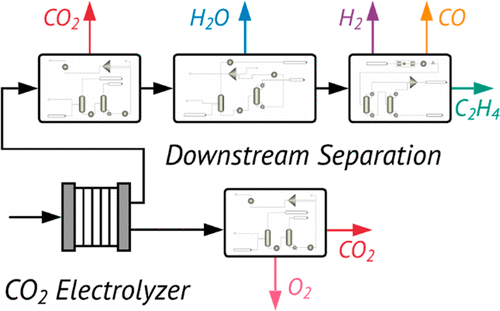当前位置:
X-MOL 学术
›
ACS Energy Lett.
›
论文详情
Our official English website, www.x-mol.net, welcomes your
feedback! (Note: you will need to create a separate account there.)
Downstream of the CO2 Electrolyzer: Assessing the Energy Intensity of Product Separation
ACS Energy Letters ( IF 19.3 ) Pub Date : 2021-11-17 , DOI: 10.1021/acsenergylett.1c02263 Théo Alerte 1, 2 , Jonathan P. Edwards 3 , Christine M. Gabardo 3 , Colin P. O’Brien 3 , Adriana Gaona 4 , Joshua Wicks 2 , Ana Obradović 5 , Amitava Sarkar 6, 7 , Shaffiq A. Jaffer 1 , Heather L. MacLean 4 , David Sinton 3 , Edward H. Sargent 2
ACS Energy Letters ( IF 19.3 ) Pub Date : 2021-11-17 , DOI: 10.1021/acsenergylett.1c02263 Théo Alerte 1, 2 , Jonathan P. Edwards 3 , Christine M. Gabardo 3 , Colin P. O’Brien 3 , Adriana Gaona 4 , Joshua Wicks 2 , Ana Obradović 5 , Amitava Sarkar 6, 7 , Shaffiq A. Jaffer 1 , Heather L. MacLean 4 , David Sinton 3 , Edward H. Sargent 2
Affiliation

|
The electrochemical reduction of carbon dioxide (CO2RR) to chemical feedstocks, such as ethylene (C2H4), is an attractive means to mitigate emissions and store intermittent renewable electricity. Much research has focused on improving CO2 electrolysis cell efficiency; less attention has been paid to the downstream purification of outlet product streams. In this work, we model the use of mature downstream separation technologies as part of the overall production of polymer-grade C2H4 from CO2. We find that CO2 removal is the most energy-intensive downstream separation step. We identify opportunities to reduce separation energies to ∼22 GJ/tonne C2H4 through necessary improvements in C2H4 selectivity (>57%), cathodic CO2 conversion (>80%), and CO2 crossover (0 mol CO2/mol e–). This work highlights the influence of cell performance parameters on downstream separation costs and motivates the development of new, efficient separation processes better suited to the distinctive outlet streams of CO2 electrolyzers.
中文翻译:

CO2 电解槽下游:评估产品分离的能量强度
将二氧化碳 (CO 2 RR)电化学还原为化学原料,例如乙烯 (C 2 H 4 ),是减少排放和存储间歇性可再生电力的有吸引力的手段。许多研究都集中在提高 CO 2电解槽效率上。对出口产品流的下游净化关注较少。在这项工作中,我们模拟了成熟的下游分离技术的使用,作为从 CO 2生产聚合物级 C 2 H 4的整体生产的一部分。我们发现 CO 2去除是最耗能的下游分离步骤。我们确定机会减少分离能以约22 GJ /吨C 2 ħ 4通过用C必要的改进2 ħ 4选择性(> 57%),阴极CO 2转化率(> 80%)和CO 2交叉(0摩尔CO 2 /摩尔– )。这项工作突出了电池性能参数对下游分离成本的影响,并推动了更适合 CO 2电解槽独特出口流的新型高效分离工艺的开发。
更新日期:2021-12-10
中文翻译:

CO2 电解槽下游:评估产品分离的能量强度
将二氧化碳 (CO 2 RR)电化学还原为化学原料,例如乙烯 (C 2 H 4 ),是减少排放和存储间歇性可再生电力的有吸引力的手段。许多研究都集中在提高 CO 2电解槽效率上。对出口产品流的下游净化关注较少。在这项工作中,我们模拟了成熟的下游分离技术的使用,作为从 CO 2生产聚合物级 C 2 H 4的整体生产的一部分。我们发现 CO 2去除是最耗能的下游分离步骤。我们确定机会减少分离能以约22 GJ /吨C 2 ħ 4通过用C必要的改进2 ħ 4选择性(> 57%),阴极CO 2转化率(> 80%)和CO 2交叉(0摩尔CO 2 /摩尔– )。这项工作突出了电池性能参数对下游分离成本的影响,并推动了更适合 CO 2电解槽独特出口流的新型高效分离工艺的开发。











































 京公网安备 11010802027423号
京公网安备 11010802027423号